I’m being a little facetious with my title, but not very.
The fully extended wings of Western Grebes are seldom seen by humans for several reasons:
- Western Grebes rarely fly
- they do fly during migration but only at night when they can’t be seen
- their flight muscles atrophy shortly after arriving on their breeding grounds so for some time after that they couldn’t fly if they tried to
- they are foot-propelled pursuit divers so they don’t even use their wings when chasing fish underwater
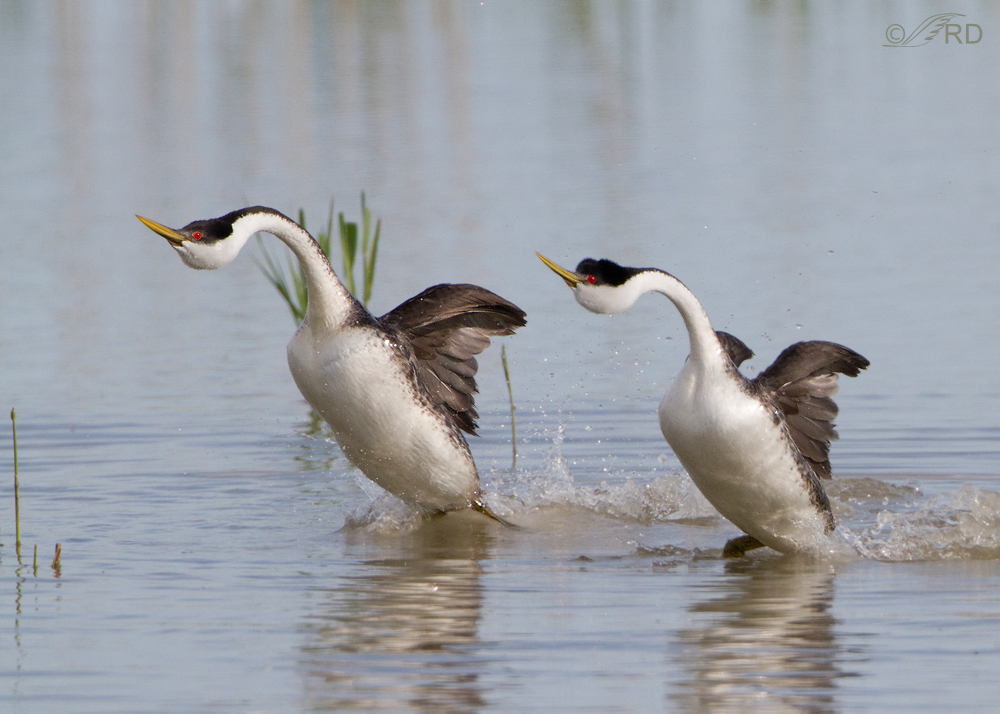
1/2500, f/7.1, ISO 500, Canon 7D, Canon EF500mm f/4L IS USM, not baited, set up or called in
The one time when some folks might see their wings partially raised is during their springtime “rushing ceremony” but even then the wings are only raised at the humerus and never extended. The rest of the wing remains folded.
But yesterday morning at Bear River Migratory Bird Refuge I did see and photograph a single Western Grebe with its wings momentarily extended as it performed a behavior that I had never before witnessed.
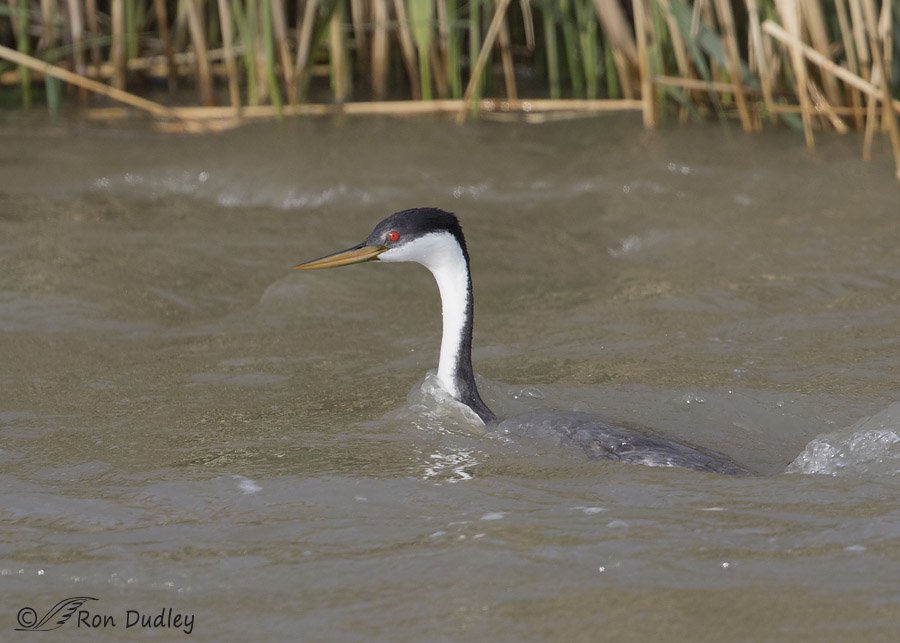
1/2000, f/7.1, ISO 800, Canon 7D Mark II, Canon EF500mm f/4L IS II USM +1.4 tc, not baited, set up or called in
Over the years I’ve spent hundreds of hours watching Western Grebes and when I’ve seen them fishing it’s nearly always been in still or very slowly moving water. But yesterday a group of them was fishing where the water was forced through a narrow channel so the current was fast. Very fast! Apparently the best fishing was at the bottom of this fastest flowing water but the current was so rapid that the birds had a very difficult time simply maintaining their position in the water, much less making any headway.
It appears that this bird is swimming rapidly forward but in reality it’s barely staying in position as it paddles furiously in the current.
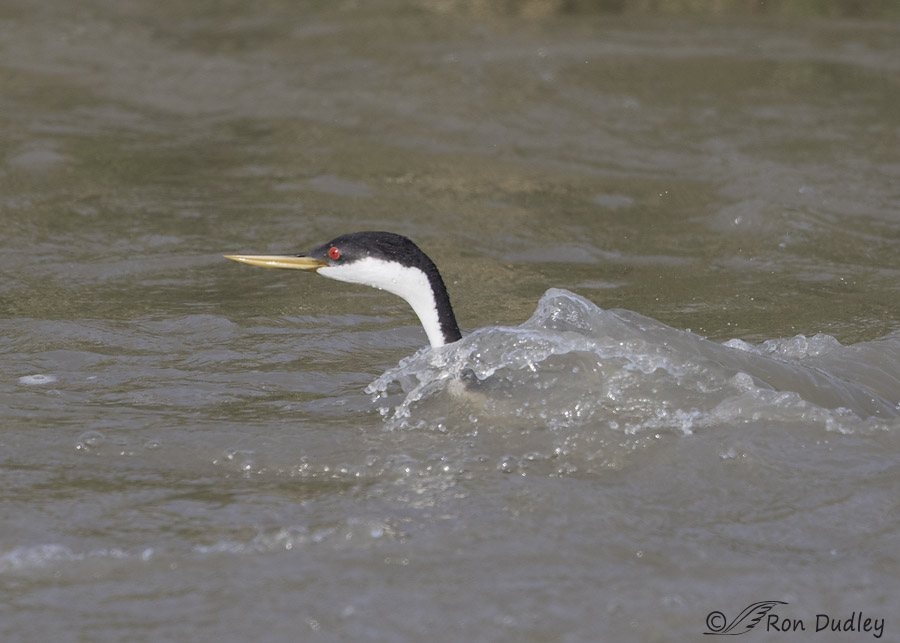
1/2000, f/7.1, ISO 800, Canon 7D Mark II, Canon EF500mm f/4L IS II USM +1.4 tc, not baited, set up or called in
In order to make any headway the birds had to paddle so hard with their rear-placed feet that the effort would actually drag most of their body under the surface before they reached their goal in the water so one grebe tried a different tactic.
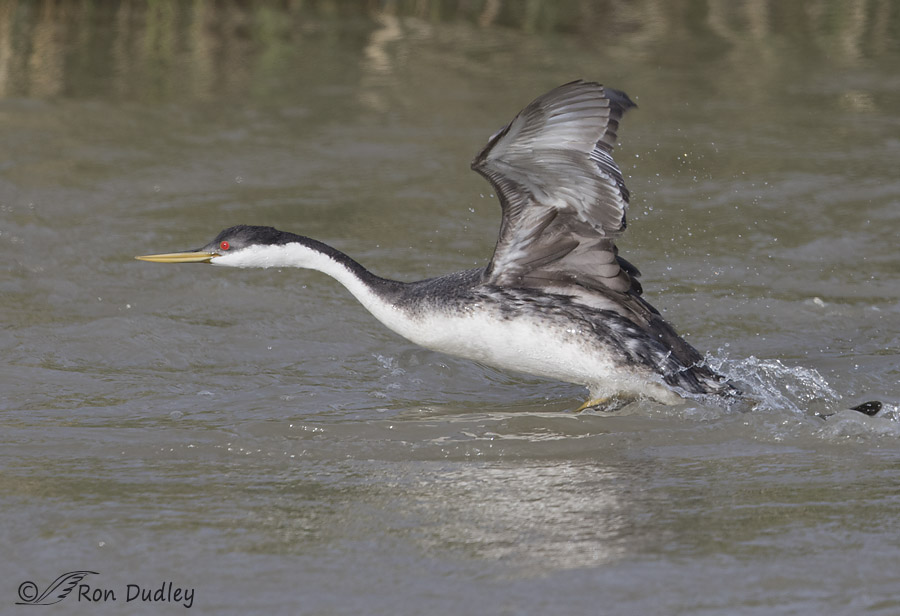
1/2000, f/7.1, ISO 800, Canon 7D Mark II, Canon EF500mm f/4L IS II USM +1.4 tc, not baited, set up or called in
It actually used its raised and extended wings as a propulsion aid to help it move forward in the current. This is a common behavior with Pied-billed Grebes but as far as I can tell in my research it’s virtually unheard of in this species. Western Grebes are incredibly fast swimmers but typically they use only their feet for propulsion.
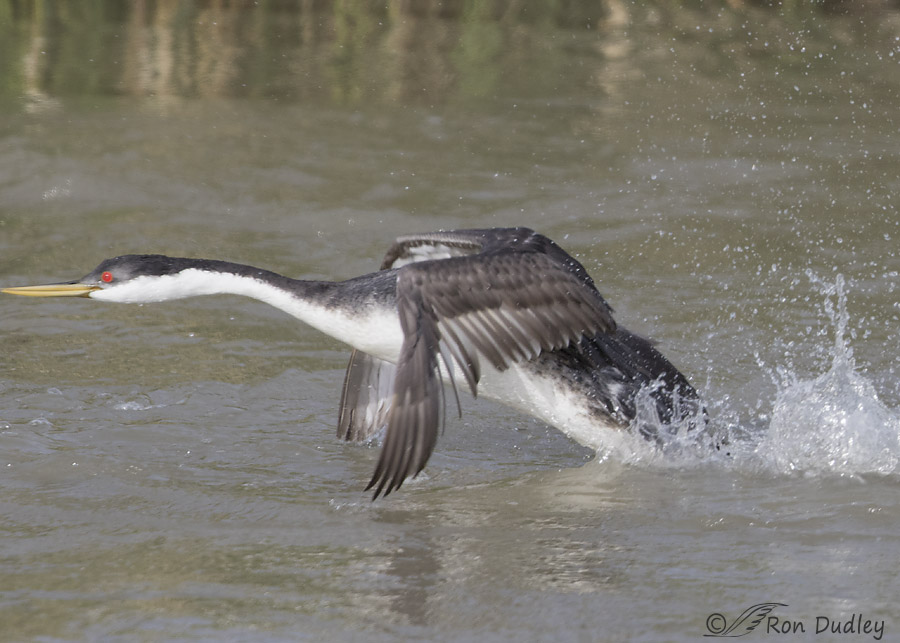
1/1600, f/7.1, ISO 800, Canon 7D Mark II, Canon EF500mm f/4L IS II USM +1.4 tc, not baited, set up or called in
As you can see in this mediocre shot (I wasn’t prepared for this behavior so I clipped the beak and the bird is a little soft) the wings are almost fully extended at the “elbow” and “hand” so that the flight feathers can be seen.
I realize that all this is likely no big deal for some but it always gets my attention when I see something new (at least to me) in the field.
Ron
PS – I’m curious to know if any of my readers have ever seen the fully extended wings of Western (or Clark’s) Grebes, other than during a wing stretch…


As a young thing I was criticised (often) for my insatiable curiosity. And your posts feed it, satisfy it, and start my monkey mind down new paths.
Thank you so much.
Another stunning post. Education and delight.
All that info about their wing strength and the diminishing power and size of their pectoral muscles , and the shrinking of their digestive organs, is fascinating…never knew any of that before! .I’m still amazed by the obvious fact that they “rush” with their heads on upside down! These are truly incredible birds!!! If you all elect me as Queen of the Country, one the first things I’m going to do is destroy all “personal water craft” and, what one son in law calls “p–is” (male teproductive organ) boats…I’m going to start with the Skidoo in Maine that caused some eagles to abandon the nest they’d used for years….a nest that so many of us enjoyed watching. They relocated to an island where few can see them.
You’ve got my vote for Queen, Patty!
So sorry about the eagle nest – for you and for them.
Make that “seado”…skidoos will be destroyed later…..
Patty, I think I like that son-in-law of yours. I like the way he thinks. 🙂
You have my vote for Queen.
I can’t comment on the behavior as I’ve never seen this species. It certainly is a very interesting observation, though! Birds can be pretty creative when it comes to reaching a food source. Recognizing that it was an unusual behavior and being astute enough to document it speaks to your field experience, scientific inquisitiveness, photographic skills and, that greatest of all gifts – “gut feeling”.
Very nice stuff, Ron!
Wally, what amazed me about this behavior (besides the fact that the bird raised its wings) is that they’re willing to expend such an incredible amount of energy to fish in those fast currents. The calorie reward from the fish there must be enough to make it worth while or I don’t think they would do it.
Interesting! I never actually knew that their flight muscles atrophied. Another lesson!
Thanks very much, Arwen.
It’s really great that you saw this new behavior and were able to document it. IMO it’s worth keeping less than spectacular photos of things like that. I, too, am always excited when I see something new.
I have a question for you: if these birds’ wings atrophy shortly after they arrive at their breeding grounds, how do they manage to migrate at the end of breeding season? I’ve never heard of anything like that before.
Susan, it isn’t their wings that atrophy, it’s their flight (breast) muscles. Those muscles regenerate again just before fall migration. The same phenomenon occurs in at least some other grebe species (Eared Grebes for example). This makes grebes quite vulnerable to human disturbance from low-brows in motorboats and other watercraft because they can’t fly to get away, only submerge.
A little more info here but there’s many more scientific articles available in a web search.
http://www.audubon.org/magazine/january-february-2014/keeping-grebes-afloat-intermountain
Here’s what one source says about Eared Grebes: (that link can be found here) – https://www.monolake.org/images/bomegr.pdf
“While feeding at the lake, the Eared Grebes more than double
their weight. The pectoral (chest) muscles shrink to the point of flightlessness, the
digestive organs grow significantly, and large fat deposits accumulate. Before the grebes
can continue on their migration, they need to fast to allow the digestive organs to shrink
back to about one-fourth their peak size, and they exercise their wings to allow the flight
muscles and heart to grow.
Thanks, Ron. As usual, I’m learning something new from my favorite teacher. 🙂
I was wondering where you got the information about the atrophy. Thanks for the links.
Ron, I spent lots of time watching grebes at Klamath falls , Putnam park, as well as Klamath lake and I never saw this,
Time under the belt for different behaviors, eh… Good job
Thanks very much for that feedback, Barb! I was hoping that it wasn’t just my poor observational skills that made me draw a false conclusion…
Simply amazing shots Ron! Thanks for sharing!
Charlotte
Thank you, Charlotte.